John and James Whitney Programme
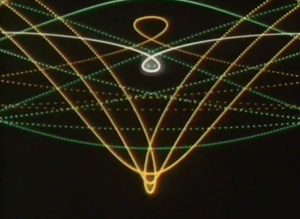
© Estate of John and James Whitney
James Whitney – Film Exercises 2 & 3 (1944, 16mm, colour, 4′) Music: synthetic sound track
The five film exercises made by John and James Whitney were more individual than collaborative works; John made the first and fifth, while James made the second and third (shown here), and the fourth. The home-made apparatus – a tunable pendulum mechanism capable of creating (independently) visual effects and synthetic sound track – was built by John, who described its operation as follows:
Our subsonic sound instrument consisted of a series of pendulums linked mechanically to an optical wedge. The function of the optical wedge was the same at that of the typical light valve of standard optical motion picture sound recorders. No audible sound was generated by the instrument. Instead, an optical sound track of standard dimension was synthetically exposed onto film which after processing could be played back with a standard motion picture projector. (John Whitney, ‘Moving Pictures and Electronic Music’, 1959)
John Whitney – Catalog (1961, 16mm, colour, 7′) Music: Ornette Coleman
Catalog is, as the title suggest, a sample reel of visual effects produced to demonstrate the ‘versatility’ of John Whitney’s ‘cam machine’, built from sophisticated, discarded mechanical WWII anti-aircraft gun directors. He described its operation in a subsequent essay, ‘Animation Mechanisms’, comparing it to his earlier pendulum system:
Instead of a point source of light capable of drawing only lines, the camera was fixed above a light field about twelve inches wide. Artwork consisted usually of film negatives of typography or rudimentary abstract patterns (clear images on an overall black field) could be orbited, rotated or moved in a great variety of compound sine function excursions within the twelve-inch light field. (‘Animation Mechanisms’, 1971)
James Whitney, Lapis (1966, HD digital transfer, colour, 10′) Music: Ravi Shankar
James Whitney used his own cam machine – built with the advice of John – to make Lapis, whose pulsating mandala forms combine a centred stillness and ceaseless variation in movement. Creating these intricate animations brought James to the realisation that he could not go further with his film-making; and it was only with the intervention of Jordan Belson that the film was finally assembled in 1966. However, for John this film remained the finest work made using the ‘cam machine’ apparatus, describing it as ‘the one film [of this time] which will probably endure’ (‘Animation Mechanisms’, 1971).
John Whitney – Permutations (1968, 16mm, colour, 8′) Music: Balachandra
During 1966-70 John Whitney received a grant from IBM as well as access to their latest family of mainframe computers, the System/360. Whitney had already begun a collaboration with IBM researcher, Dr Jack Citron, who wrote the programming language and applications for this project. Whitney filmed the on-screen display onto high contrast 35mm film, using his own modified camera, which he then processed using optical printing. The film was also shown at the Cybernetic Serendipity event at the ICA, London, in August 1968, for which Whitney supplied the following description:
The film contains various types of dot patterns which might be compared to the alphabet. At the next level of complexity the dot patterns are formed into ‘words’, each word having basically a 200-frame time duration. The words in turn can be fitted contextually into sentence structures. … I must strain the parallel beyond its limits in order to explain that these patterns are graphically superimposed over themselves forward and backward in many ways, and the parallel is now with the counterpoint, or at least polyphonic musical material. (‘Permutations’, Cybernetic Serendipity, 1968)
John Whitney – Osaka 1-2-3 (1970, 16mm, monochrome, 3′) Music: unspecified kabuki music
This short black and white film, like Permutations, dates from Whitney’s IBM fellowship, but credits staff at IBM Labs in Rochester, NY, rather than LA/Citron. Each sequence illustrates a movement from a stable geometric shape to a state of disorder, and back again.
John Whitney – Matrix 3 (1972, HD digital transfer, colour, 11′) Music: Terry Riley
Made at Information International Inc. (Triple-I or III), with programming by Dean Anschultz, Matrix 3 presents Whitney’s experiments with an ‘unpredictable’ illusory three-dimensionality: as groups of hexagons of different sizes trace paths in a figure eight pattern, they coagulate to give the perspectival illusion of a group of cubes.
John Whitney – Arabesque (1974, HD digital transfer, colour, 7′) Music: Manoocheher Sadeghi
The variations of Arabesque are generated by transformations applied to an array of 360 points around a circle. Once again produced at Triple-I, during the system weekend downtime, Whitney worked this time with Larry Cuba as programmer/collaborator to produce the footage that he would then take home to colour process using his optical printer.
More dynamic than my other films, the colour is in constant flux. Color changes almost every frame in smooth transformations by means of the installation of a colour wheel at the optical focus of the condenser light source. (‘Arabesque – An Analysis’, Digital Harmony, 1980)
John and James Whitney programme notes by Dr Richard Stamp (BSU)
Fixed Media Works Programme 1
Bret Battey – Clonal Colonies (second movement, 9’)
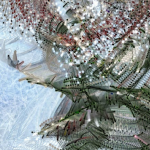 Clonal Colonies was commissioned by New York’s Avian Orchestra for their botany-themed concert Vegetative States in 2011. The first movement, Fresh Runners, is a fast romp of densely interlocked textures, thrilling in the process of transformation itself. The second movement, Soft Strata, starts with an almost childlike simplicity, from which a series of gentle elaborations culminate in a not-so-gentle interjection. It returns to something akin to its original state, but impelled by evolution to exhibit greater richness and nuance.
Clonal Colonies was commissioned by New York’s Avian Orchestra for their botany-themed concert Vegetative States in 2011. The first movement, Fresh Runners, is a fast romp of densely interlocked textures, thrilling in the process of transformation itself. The second movement, Soft Strata, starts with an almost childlike simplicity, from which a series of gentle elaborations culminate in a not-so-gentle interjection. It returns to something akin to its original state, but impelled by evolution to exhibit greater richness and nuance.
A “clonal colony” is a group of genetically identical plants. Child plants are propagated by “runners” that emerge from a parent plant. Thus colony members may appear as individual plants above the ground, but are interconnected underground. The environment for each plant, which includes neighboring colony members, shapes the unique appearance of that plant. This is analogous to the computer algorithms used in the creation of the music. Each musical phrase can be thought of as the disposition of a single plant. All instrumental parts share the same underlying “genetic code”. But each instrumental behavior influences and is influenced by the others’. This ecosystem, when tended with care by the composer-gardener, can give rise to engaging behavioral counterpoint, sometimes of surprising and hard-to-rationalize coherence. I trimmed and weeded the resulting acoustic garden while adding computer-rendered sound. The latter provides color settings, delineates boundaries, clarifies landmarks — and highlights the fundamental pulse of the landscape.
The video element extends my previous Brownian Doughnut Warper technique of algorithmic manipulation of points by adding Bézier splines between points, camera control, and post-processing routines. Complex patterns arising from the lines between points forms a further analogy to botanical clonal colonies.
Biography:
Bret Battey (b. 1967) creates electronic, acoustic, and multimedia concert works and installations. He has been a Fulbright Fellow to India and a MacDowell Colony Fellow, and he has received recognitions and prizes from Austria’s Prix Ars Electronica, France’s Bourges Concours International de Musique Electroacoustique, Spain’s Punto y Raya Festival, Abstracta Cinema of Rome, and Amsterdam Film eXperience for his sound and image compositions. He pursues research in areas related to algorithmic music, digital signal processing, image and sound relationship, and expressive synthesis, with papers published in Computer Music Journal and Organised Sound. He completed his masters and doctoral studies in Music Composition at the University of Washington and his Bachelors of Music in Electronic and Computer Music at Oberlin Conservatory. His primary composition and technology teachers have been Conrad Cummings, Richard Karpen, and Gary Nelson. He also served as a Research Associate for the University of Washington’s Center for Digital Arts and Experimental Media. He is a Senior Lecturer with the Music, Technology, and Innovation Research Centre at De Montfort University, Leicester, UK.
Bill Alves – Static Cling (7′ 48″)
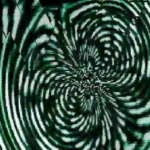 Static Cling was inspired by the resonant patterns that emerge from the chaos of our world, like the patterns one can see in interstation tuning. The soundtrack is derived entirely from the sounds of the nightly ritual chaos of local news broadcasts, much as the animation is created from patterns of visual resonance. In this way beats, harmonies, and visual designs converge on the same Pythagorean relationships.
Static Cling was inspired by the resonant patterns that emerge from the chaos of our world, like the patterns one can see in interstation tuning. The soundtrack is derived entirely from the sounds of the nightly ritual chaos of local news broadcasts, much as the animation is created from patterns of visual resonance. In this way beats, harmonies, and visual designs converge on the same Pythagorean relationships.
Biography:
Bill Alves is a composer, writer, and video artist based in Southern California. He has written extensively for conventional acoustic instruments, non-Western instruments – especially Indonesian gamelan – and electronic media – especially in the integration of music with abstract animation. CDs of his audio works include The Terrain of Possibilities (EMF), Imbal-Imbalan (Spectral Harmonies), and Mystic Canyon (MicroFest), and his video works are available on the dvd Celestial Dance (Kinetica Video Library). He is the author of the book Music of the Peoples of the World (Schirmer/Cengage), now in its third edition. In 1993-94 he was a Fulbright Senior Scholar Fellow in Indonesia, where he extensively studied the gamelan orchestra music of Java and Bali. He currently directs the HMC American Gamelan and a Visual Music Ensemble. He teaches at Harvey Mudd College of the Claremont Colleges.
Aaron F. Ross – Music for a Self-Transforming Machine (3′)
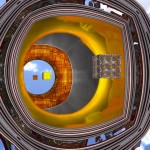 Aesthetic machine
Aesthetic machine
Virtual architecture
Unfrozen music
Inevitably
Celestial music box
Folds inside itself
Recursive sculpture
Fractal ego-boundary
Chaos in motion
Biography:
Aaron F. Ross is a video producer, author, and educator. His abstract video and computer animation has screened at prestigious festivals and venues such as SIGGRAPH, ISEA, Berlin Interfilm, Geneva Videoweek, and the Exploratorium. Over the years he has worked professionally in various roles: director, editor, videographer, 3D computer modeler, animator, and sound designer. His commercial video and animation work has been broadcast on major TV networks such as CNN and Fox. Aaron is an expert in 3D animation, and has written or co-written three books on the subject. He has years of experience teaching university and professional development courses. He currently operates a training website for 3D artists, digitalartsguild.com. His personal work can be found at dr-yo.com.
Jon Weinel – Mezcal Animations (4′)
Mezcal Animations is a piece of visual music with electroacoustic sound. I use a technique called ‘direct animation’, which involves applying paint, ink and other materials directly to standard 8mm film. While continuing to explore similar altered states of consciousness aesthetics as my previous works, in my own way, the piece is a tribute to Oaxaca’s International Mezcal Festival of 2012.
I. Mezcal Reposado / Pensamiento (0’13”)
II. Mezcal Tobala / El Golpe (2’30”)
III. Sal de Gusano (3’44”)
Biography:
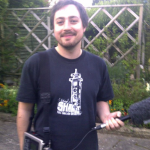 Jon Weinel is a sonic artist and researcher. He holds a PhD in Music Technology, completed at Keele University under the supervision of Prof.Rajmil Fischman. He has taught at Keele University, Manchester Metropolitan University, and is currently a Postdoctoral Researcher at Glyndwr University.
Jon Weinel is a sonic artist and researcher. He holds a PhD in Music Technology, completed at Keele University under the supervision of Prof.Rajmil Fischman. He has taught at Keele University, Manchester Metropolitan University, and is currently a Postdoctoral Researcher at Glyndwr University.
His main expertise is in audio design and composition of psychedelic music. He creates sound for sonic arts, video games, audio-visual projects and carries out research broadly related to these areas.
Maxime Corbeil-Perron – Ghostly (6′ 35″)
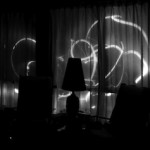 Ghostly is a stop-motion animated short film that explores the movement of shadows and lights through the use of different frame-rates, with a flow of images moving from 6fps to 48fps.
Ghostly is a stop-motion animated short film that explores the movement of shadows and lights through the use of different frame-rates, with a flow of images moving from 6fps to 48fps.
Biography:
A child of rock and electronic music, Maxime Corbeil-Perron draws inspiration from the instrumental tradition and nature to create a personal, abstract, and lively sound world. The Montreal-based composer divides his time between the new music scene, video art and the local underground scene.
He won first prize in the Jeu de temps / Times Play (JTTP) competition (Canada, 2011), a special mention and medal of the Senato della Repubblica Italiana at the Città di Udine competition (Italy, 2012), second prize from the Destellos Foundation competition (Argentina, 2012) as well as a special mention from Musicworks International Electronic Music Contest (Canada, 2012). His music has been distributed by Taukay Edizione Musicali and Vox Novus.
Maxime recently graduated with high honours from the Conservatoire de Musique de Montréal, with a Master¹s degree in electroacoustic composition. His work has been supported by the Canada Council for the Arts and the Conseil des Arts et Lettres du Québec.
Maura McDonnell – Variegated Beat (4′ 17″)
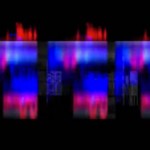 Variegated Beat is a visual music piece that explores the beats and rhythms of the music soundtrack. a music composition piece by Cignol/Sean Reed. The piece was created in response to an invite by Diatribe, the label representing the music. Variegated refers to the multiple colours that have been used to explore visual beats that are equivalent to the music beats. The work was created in after effects and the source material for all the visuals is one very small blue square generated as a solid in after effects! So although the imagery is suggestive of real things and evocative, it has been solely generated from this one square!
Variegated Beat is a visual music piece that explores the beats and rhythms of the music soundtrack. a music composition piece by Cignol/Sean Reed. The piece was created in response to an invite by Diatribe, the label representing the music. Variegated refers to the multiple colours that have been used to explore visual beats that are equivalent to the music beats. The work was created in after effects and the source material for all the visuals is one very small blue square generated as a solid in after effects! So although the imagery is suggestive of real things and evocative, it has been solely generated from this one square!
Biography:
Maura McDonnell is a PhD candidate on the Digital Arts and Humanities programme at Trinity College, Dublin, and based at the Arts Technology Research Lab in Trinity College and was awarded a Digital Humanities and Arts Fellowship to complete her PhD studies. Her PhD topic is on visual music and embodied cognition and involves an arts practice component. Maura is also a practicing visual music artist, and a part-time lecturer on the M.Phil. in Music and Media Technologies programme at Trinity College.
After discovering the power of sound and image by completing a number of experimental audio-visual works, Maura has since and continues to embark on an inquiry into the origins and existing practice in visual music and creates visual music works as a solo artist and also in collaboration with music composers. For this purpose, she keeps a blog and website at http://visualmusic.blogspot.com and http://www.soundingvisual.com
Maura’s visual music pieces have been shown around the world: China, Finland, Germany, Ireland, Singapore, US, UK. Her collaborative work Silk Chroma (2010) with the Irish Composer Linda Buckley and sound and acoustics experts Dermot Furlong and Gavin Kearney won an honourary visual music award at the Visual Music Award at Frankfurt, Germany in 2011.
Alison Clifford and Graeme Truslove – Turbulence (3′ 18″)
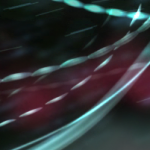 ‘Turbulence’ (2013) forms part of the ‘Interstitial Articulations’ series of audiovisual works by artist Alison Clifford and composer Graeme Truslove. The series explores the space between sound and image through collaboration and is based around reinterpretations of a number of photographic light paintings taken during a drive at night. The photographs were experiments – improvisations with long exposures, motion and gesture. The light-forms that resulted were chance occurrences, combining the momentary fleeting headlights of passing traffic and the movements of the photographer, resulting in a series of abstract, ‘interstitial’ (in between) forms.
‘Turbulence’ (2013) forms part of the ‘Interstitial Articulations’ series of audiovisual works by artist Alison Clifford and composer Graeme Truslove. The series explores the space between sound and image through collaboration and is based around reinterpretations of a number of photographic light paintings taken during a drive at night. The photographs were experiments – improvisations with long exposures, motion and gesture. The light-forms that resulted were chance occurrences, combining the momentary fleeting headlights of passing traffic and the movements of the photographer, resulting in a series of abstract, ‘interstitial’ (in between) forms.
Considering these ethereal forms as source materials, the series imagines what it would be like to experience them in different contexts beyond the photographic image. How might they be reinterpreted and rewritten for another context? And how might audio be used to structure our visual experience of them?
‘Turbulence’ (2013) – the fourth work resulting from the collaboration – explores motion through simulations of natural forces.
Biographies:
Alison Clifford is an artist based in Glasgow. Her work is concerned with defining notions of the interstitial – or in-between – through digital art. She is interested in processes of translation between different forms of media, considering the new creative possibilities that result from what is lost or gained through such interpretation. Outputs include net-art, experimental film, interactive works and audiovisual installations. She has exhibited widely in various international new-media and electronic art festivals and exhibitions, and has received several prestigious awards and commissions. These include a BAFTA nomination for interactive media, a commission from San Francisco Museum Of Modern Art, and recent inclusion in the second edition of the Electronic Literature Collection.
For more information please visit:
Graeme Truslove (PhD) is a composer and performer based in Glasgow. His output includes: electroacoustic and instrumental compositions, theatre sound design, audio-visual installations and improvisation (performing on guitar and laptop). His work is largely concerned with conflicts between intuitive performance and the fixed-medium, often exploring how fixed-medium expressive and structural possibilities can be integrated into improvised performance and vice versa. His approach integrates multiple strata of musical time, ranging from macrostructure down to the formation of timbre itself. Truslove’s work has been performed internationally, and has attracted various awards, including 1st prize in Métamorphoses 2010, Belgium.
More info is available at:
Jean Piché – Heliograms (20′ – short version)
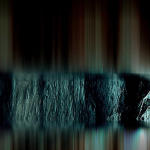 Heliograms (cahier visuel) is a videomusic suite composed on three computer music works I wrote in the late 1970s. The three works, along with La mer à l’aube, were reedited on the Digitalis label in 2012. The cahier proposes a flowing illumination of Ange, Rouge & Heliograms. Ange, for voice and computer sounds, was composed at Stanford University on the Systems Concept Digital Synthesizer and espouses a contemplative mode that was unusual at the time. Rouge is a raging rhythmical piece for percussion exploring iridescent metallic timbres. Heliograms, the eponymous piece of the cahier, was composed with reference to an early technique of solar messaging using mirrored sunlight. The visual rendering of the three sections reaffirms their individual musical and qualities.
Heliograms (cahier visuel) is a videomusic suite composed on three computer music works I wrote in the late 1970s. The three works, along with La mer à l’aube, were reedited on the Digitalis label in 2012. The cahier proposes a flowing illumination of Ange, Rouge & Heliograms. Ange, for voice and computer sounds, was composed at Stanford University on the Systems Concept Digital Synthesizer and espouses a contemplative mode that was unusual at the time. Rouge is a raging rhythmical piece for percussion exploring iridescent metallic timbres. Heliograms, the eponymous piece of the cahier, was composed with reference to an early technique of solar messaging using mirrored sunlight. The visual rendering of the three sections reaffirms their individual musical and qualities.
Biography:
Jean Piché is a composer, video artist, software designer and professor at the Université de Montréal. His creative output over the past 40 years has explored the more exotic edges of high technologies applied to music and moving images, including visual music, live electronics, fixed electronic media and performance. He has received numerous international awards and his work has been presented in Europe, Asia and North America. He now concentrates his practice on visual music, focusing on parallel compositional strategies for abstracted visuals and music, a new hybrid form he has helped define. He has been heavily involved in software design, notably with the program Cecilia and the TamTam suite on the celebrated One Laptop per Child computer from MIT. He presently directs the institut Arts, Cultures et Technologies (iACT), a new media research collective at the Université de Montréal.
Fixed Media Works Programme 2
Zai Tang and Simon Ball – Exploit (Bukit Brown Cemetery II) (3′)
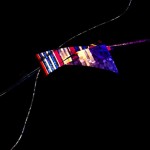 One of the largest Chinese graveyards outside China, Bukit Brown Cemetery is home to 100,000 graves, including many of Singapore’s early pioneers. The 200-hectare woodland habit also assumes the role of sanctuary to a colourful array of wildlife, including a handful of vulnerable and endangered bird species. Despite its historical and ecological significance, part of Bukit Brown will make way for a 4-lane highway to begin construction in the coming months, whilst the rest of it will eventually be displaced by new public housing in the decades to follow.
One of the largest Chinese graveyards outside China, Bukit Brown Cemetery is home to 100,000 graves, including many of Singapore’s early pioneers. The 200-hectare woodland habit also assumes the role of sanctuary to a colourful array of wildlife, including a handful of vulnerable and endangered bird species. Despite its historical and ecological significance, part of Bukit Brown will make way for a 4-lane highway to begin construction in the coming months, whilst the rest of it will eventually be displaced by new public housing in the decades to follow.
Exploit (Bukit Brown Cemetery II) is one of two works concerning the transformation of Bukit Brown’s acoustic environment, stemming from an on-going soundscape study that Zai began in May 2013. The work takes the form of a digitally animated visual-music piece that makes use of field recordings from the study. The collaborators were curious to discover how far they could develop a work together when regarding the sound material purely as sound-objects (i.e. apprehended without any relation to its source). Any ethical concerns pertaining to the treatment of material as living things from Bukit Brown have been put aside, so that the primary aim of creating a rich and dynamic synaesthetic experience can be achieved – the material is simply a stepping-stone for the collaborators own progress.
Situated within the narrative of Singapore’s perpetual morphosis, the work encourage us to question the extent to which a sacrifice is justifiable for the sake of development.
Biographies:
Zai Tang (sound) is an artist, composer and sound designer based in London / Singapore. Building upon a broad range of solo and collaborative experience, Zai is branching out of his background in site-specific installation, composition for moving-image and improvised turntable music, to further explore the terrain between sound, body and space. Zai studied BA Creative Music Technology at Bath Spa University, and completed his Masters in Digital Arts at University of Arts London.
After studying Media and Film production in Bristol, UK, Simon Ball (image) completed his masters in Digital Arts at University of the Arts, London. His creative practice spans Moving Image, Animation, Photography and Installation based projects. His recent work engages with Film as a phenomenological medium, utilising photography and animation to explore the nature of time and movement, with a particular interest in how the medium relates to the urban environment.
Clive Walley – The Divertimenti (2 x 3′)
 The Divertimenti were commissioned by BBC2 in the early 90’s. There six three minute films in the sequence (two are shown here). They were broadcast as “Space Time and Paint” a 30 minute semi-documentary about the making of them. Each film uses a different composer and a visualising relationship with the track was established by close synchronisation of moving paint with the music. The moving paint method was pre digital and unique and was perfected during this sequence. They won international successes at the festivals and have not been seen since.
The Divertimenti were commissioned by BBC2 in the early 90’s. There six three minute films in the sequence (two are shown here). They were broadcast as “Space Time and Paint” a 30 minute semi-documentary about the making of them. Each film uses a different composer and a visualising relationship with the track was established by close synchronisation of moving paint with the music. The moving paint method was pre digital and unique and was perfected during this sequence. They won international successes at the festivals and have not been seen since.
Biography:
Born 1943 farming family. Manchester University Engineering degree, Bangor University Dip Ed (Maths Physics and Art!).
Regular painting shows in North Wales area, then tried animating the paintings for TV with some success.
Now semi-retired in Frome making art installations about Painting and being part-time curator for the Black Swan Arts Centre.
Jean Detheux and Jean Derome – Machinalement (v32) (5′ 58″)
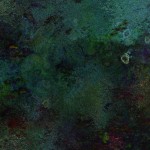 Latest installment in the “Machinalement” series (I made over 50 versions), based on masterful flute improvisations by the truly remarkable Montréal musician Jean Derome (actuellecd.com/en/bio/derome_je/).
Latest installment in the “Machinalement” series (I made over 50 versions), based on masterful flute improvisations by the truly remarkable Montréal musician Jean Derome (actuellecd.com/en/bio/derome_je/).
“Listening with my eyes,” the focus is on that sensitive and elusive space that can exist between the music and the images, not trying at all to mirror the music, but not ignoring it either.
You can see Jean Derome at work in this movie: vimeo.com/15167866.
Some of the source images were created during my Summer residency at the “institut Arts Cultures et Technologies” of the Université de Montréal: iact.umontreal.ca/site/?p=1398
Music recorded by Robert Langlois at his Studio 270 in Montréal (studio270.ca)
Biography:
Belgian born, graduate of the Académie Royale des Beaux-Arts (Liège). In Canada/U.S since 1971.
Has taught “Art” in Canada and the US (NY Studio School of Drawing, Painting and Sculpture, NYU, Concordia U., Alberta College of Art, etc.).
Artwork in private/public collections (in Europe, the Americas, Asia and the Middle-East).
Left “natural media” (1997, due to allergies to painting materials) for digital technology (started exploring “time-based art”).
Films with the National Film Board of Canada (“Liaisons” and “Rupture”), numerous films in festivals since 2005.
Focuses on the importance of the hand gesture in image making (“le geste révélateur”), and especially, on the exploration of “inherent animation” (that which is done/found “by accident”), avoids “smarts” like the plague.
Lectures, conducts master-classes (including in music schools), makes films and also participates in concerts, creating images in real-time in collaboration with musicians.
Andy Dolphin – Ripple (6′ 26″)
Reflections, undulations and distortions.
Biography:
Andy Dolphin is a composer, digital artist and lecturer.
Tim Howle (music) and Nick Cope (video) – Globus Hystericus (7’)
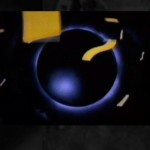 Globus Hystericus is a piece of audio-visual art that utilises the two media in an equitable way. The principles of acousmatic music are extended to incorporate parallel ideas found in video art. By taking these ideas beyond diegetic/non-diegetic and simple underpinning or reinforcement, the sounds are imbued with multiple meanings. Therefore, the piece exploits post-acousmatic possibilities. The primary objective of this investigation is to examine the creative relationships between visual and audio material in terms of hybridisation, the research seeks to establish an equitable, collaborative, approach typified by the ‘audio-visual contract’ (Chion 1994), where ‘source-recognition’ and other ‘dislocations’ become a series of creatively exploitable parameters regarding the relationship between untreated and treated and sounds and images.
Globus Hystericus is a piece of audio-visual art that utilises the two media in an equitable way. The principles of acousmatic music are extended to incorporate parallel ideas found in video art. By taking these ideas beyond diegetic/non-diegetic and simple underpinning or reinforcement, the sounds are imbued with multiple meanings. Therefore, the piece exploits post-acousmatic possibilities. The primary objective of this investigation is to examine the creative relationships between visual and audio material in terms of hybridisation, the research seeks to establish an equitable, collaborative, approach typified by the ‘audio-visual contract’ (Chion 1994), where ‘source-recognition’ and other ‘dislocations’ become a series of creatively exploitable parameters regarding the relationship between untreated and treated and sounds and images.
Biographies:
Tim Howle
Is currently Professor of Contemporary Music at University of Kent. Previously he taught composition at the University of Hull. His work centres on electroacoustic music including pieces for tape, performer and live electronics and pieces involving visual media. His work has been performed throughout the US, the EU and Asia.
Nick Cope
Currently works as Senior Lecturer in Video and New Media Production at the University of Sunderland. Graduated in 1986 from Sheffield Hallam University and worked freelance in film and video production with a particular emphasis on music and moving image work, collaborating with Cabaret Voltaire, the Butthole Surfers, O yuki Conjugate and Electribe 101 amongst others. More recent work has included projection work for public arts projects and installation collaborations.
Patrik Lechner – rt3 (10′)
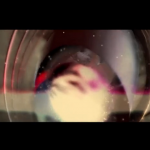 A recording of an audiovisual improvisation. Everything generated in realtime.
A recording of an audiovisual improvisation. Everything generated in realtime.
Audio is controlled/generated by Max/Msp.
Also some outboard equipment is used for synthesis. It is, in fact a purely synthetic work in the sense that nor recordings are used that have not been created synthetically by the composer.
Biography:
Patrik Lechner, born in Vienna, Austria, 1986, started to work with synthetic music at the age of 16. Since then he is developing software for audio and video improvisation. He had concerts in Austria, Italy, Germany, Dubai, and Shanghai, where he played for 3 Month at the EXPO 2010. He is having many collaborations with Painters, classical Composers and musicians but also performance artists. Also, at the moment Patrik Lechner is working at an Austrian TV station as an Audio Engineer, Research Assistant at a Univesity(FH St.Pölten) at the institute of Media Technology and has been working as a Consultant for example for the famous Burg Theater Wien for Max/MSP intergration in their audio system.
Giorgio Magnanensi – noisescope (3′ 03″)
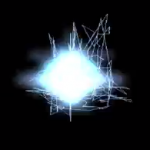 Seeking to link the seemingly disparate phenomena of sight, movement, noise and sound, I have been researching and experiment to implement, integrate and conjugate sound within visual imagery and choreographic structures and to explore methods and devices, which can translate sound and movement into an audio-visual presentation.
Seeking to link the seemingly disparate phenomena of sight, movement, noise and sound, I have been researching and experiment to implement, integrate and conjugate sound within visual imagery and choreographic structures and to explore methods and devices, which can translate sound and movement into an audio-visual presentation.
My work aspires to be speechless, without the urgency of communicating anything. If it expresses anything at all, that is pure character, essence more than intentionality. It manifests potential energy more than activity, relying on its own bare existence: an imaginary scenography without any specific kind of narrative or message.
Sonorous spaces – like traversable spaces – map our perception of time; and to light sound should be compared when sound is not just what we hear but also the medium of our perception. If we understand the close relation here between listening and seeing, sound and light; then visualizing sound is like understanding that is not about what we “see” as what we ”see in”: theatricality.
Biography:
Born and raised in Italy, Giorgio Magnanensi (1960) currently lives in Roberts Creek on the Sunshine Coast of British Columbia, Canada. His diverse artistic practice includes composition, conducting, improvisation, circuit–bending and video art. From the early 80’s to date he has been working as a composer, conductor, teacher, and performer in Europe, Japan and Canada. He is artistic director of Vancouver New Music, Laboratorio Arts Society and lecturer at the School of Music of The Vancouver Community College.
David Mc Donald – Percussion in Colour (5′)
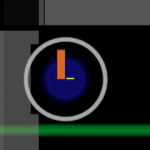 Percussion in Colour is a short abstract animated film for fixed media. Drawing on the study of Temporal Gestalt Perception in Music it is intended to be a visual representation how our auditory system processes continuous and sequential streams of short audio events.
Percussion in Colour is a short abstract animated film for fixed media. Drawing on the study of Temporal Gestalt Perception in Music it is intended to be a visual representation how our auditory system processes continuous and sequential streams of short audio events.
Inspired by the pioneering Avant-garde film makers of post war Germany such as Hans Richter and Oskar Fishinger, it utilizes the basic Bauhaus principle of harmony between the function of an object and its design. Simple geometric forms, squares, circles, rectangles and lines are each assigned to an individual audio event. Emphasizing the contrast in proportion, position and duration of the event, rather than the object itself. Allowing the rhythmical nature of the composition both audio and visual to dominate.
The audio composition is in itself a study of rhythmical construction and deconstruction. Twenty one individual sounds are added and removed in a sequential manner. As each new event / beat is added, it takes precedent over the last, forming new patterns and new configurations. Our auditory system attempts to continually connects these events into associated groups/rhythms. Continually shifting as the patterns grow, fuse and break apart.
The visual composition connects and reinforces what we hear with what we see. Instead of visually orchestrating the audio piece with colour and moving shapes, the detail of each frame of each visual element is painstakingly synced to the temporal details of its assigned audio event to create a tightly synchronized audio-visual experience.
Biography:
 David Mc Donald is an electroacoustic composer and engineer based in Dublin, Ireland. Having spent many years as a typically frustrated touring musician, artistic and creative freedom is now being sought through the medium of visual music and the psychoacoustic byproducts that are possible within.
David Mc Donald is an electroacoustic composer and engineer based in Dublin, Ireland. Having spent many years as a typically frustrated touring musician, artistic and creative freedom is now being sought through the medium of visual music and the psychoacoustic byproducts that are possible within.
Having studied composition under Donnocha Dennehy and Linda Buckley, David’s compositional work has to date been performed by Crash Ensemble, Cora Venus Lunny and Michelle O’ Rourke.
David is a recent first class honours graduate of the M.Phil Music & Media Technologies programme, Trinity College, Dublin.
Robin Price – postrush (5’45”)
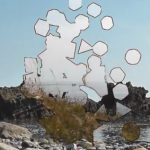 This piece uses both the MIDI score and the multichannel waveform of a synthesised ambient acid piece to control the parameters of a semi abstract video. Composed using footage of Welsh beaches, with sounds from Cornish ones and named after the misspelling of an Irish coastal beauty spot it serves as a conflation of the Celtic coast as romanticised by the English.
This piece uses both the MIDI score and the multichannel waveform of a synthesised ambient acid piece to control the parameters of a semi abstract video. Composed using footage of Welsh beaches, with sounds from Cornish ones and named after the misspelling of an Irish coastal beauty spot it serves as a conflation of the Celtic coast as romanticised by the English.
Biography:
Robin Price has been interested in electronic and audiovisual music since he found a working oscilloscope in a skip at Worcester Technology College 10 years ago where he was studying for a City and Guilds in sound recording. He recently gained his PhD, titled ‘Metadata and Interactivity in Sonic Art’, at SARC in 2013. Prior to coming to Belfast Robin gained his MPhys in Theoretical Physics from Swansea University.
His artworks have included ‘prepared’ radio set, television and ping pong table installation pieces, online works, pieces for audience interaction and a selection of externals, patches and software released to the public. He has presented his work at Belfast’s Catalyst Arts, PS2 gallery, ISEA and at NIME and STEIM conferences.
His current research interests include the use of databases, sampling, metadata and visuals in live improvised electronic music and pieces designed for audience interaction. Robin enjoys playing the double bass, programming the 303 and making acid.
Teresa Connors and Shannon Harris – Terroir (6′ 36″)
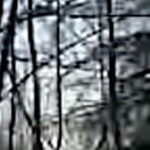 Terroir, which comes from the French word terre (“land”) and loosely translates as “a sense of place,” is an abstract portrait of personal geography as well as a formal investigation of digital media. Captured entirely on an old cell phone, the raw data used to create Terroir was collected by Canadian filmmaker Shannon Harris over a two-year period while commuting across Canada for various jobs. The camera records a landscape in constant motion, but due to the rudimentary technology the image fractures and oscillates between figurative and abstraction. Married to the painterly visuals is a sonic composition generated solely from the personal voice messages left during this time period. From this data, an allegory emerges based on the notion of communication and distance, technology and intimacy, an innate human need for community and love, and the contemporary means by which it is achieved. It is a personal journey and geography of modern life, in which people seem to be constantly ‘on the move’, filtered through the technology of the cell phone.
Terroir, which comes from the French word terre (“land”) and loosely translates as “a sense of place,” is an abstract portrait of personal geography as well as a formal investigation of digital media. Captured entirely on an old cell phone, the raw data used to create Terroir was collected by Canadian filmmaker Shannon Harris over a two-year period while commuting across Canada for various jobs. The camera records a landscape in constant motion, but due to the rudimentary technology the image fractures and oscillates between figurative and abstraction. Married to the painterly visuals is a sonic composition generated solely from the personal voice messages left during this time period. From this data, an allegory emerges based on the notion of communication and distance, technology and intimacy, an innate human need for community and love, and the contemporary means by which it is achieved. It is a personal journey and geography of modern life, in which people seem to be constantly ‘on the move’, filtered through the technology of the cell phone.
Biographies:
Teresa Connors is active in many aspects of music: acoustic/electroacoustic composer, opera singer, film scorer, and multimedia installation artist. She collaborates with a multitude of artists from diverse backgrounds and sensibilities. Originally from the musically rich island of Newfoundland, Canada, Teresa holds a Master of Music degree in composition (1st class honours) from Waikato University in New Zealand and studied both composition and opera singing at Dalhousie University in Nova Scotia as well as the Banff Center for the Arts. Her creative works have received awards and support from the Canada Council for the Arts, British Columbia Arts Council, Bravo Fact and have been presented at international conferences, film festivals, and galleries. Her current PhD creative practice research at Waikato includes developing new methodologies and techniques for multimedia collaborations.
Shannon Harris is a Canadian filmmaker originally from Vancouver B.C. and now based in Montreal Quebec. Her film and digital work reflect a creative practice rooted in personal experience and she is interested in both experimental and documentary filmmaking. Shannon is currently finishing her Masters of Fine Arts at Concordia University.
(all programme notes and biographies supplied by artists)